
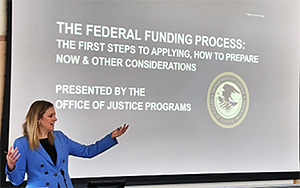 Katharine T. Sullivan, Principal Deputy Assistant Attorney General for the Office of Justice Programs, addressed a training and outreach session for potential grant applicants from rural and tribal communities in Minnesota.
Katharine T. Sullivan, Principal Deputy Assistant Attorney General for the Office of Justice Programs, addressed a training and outreach session for potential grant applicants from rural and tribal communities in Minnesota.The Office of Justice Programs (OJP) recently sponsored training and outreach sessions in nine states to educate rural and tribal organizations and agencies about funding opportunities from OJP and offer guidance for communities interested in applying for Department of Justice (DOJ) grants. Sessions in a tenth state are planned for late April. The Attorney General has set a high priority on expanding the Department’s support of public safety in less populated areas of the country.
To date, sessions have been held in Arizona, Kansas, Minnesota, Montana, New Mexico, North Dakota, Pennsylvania, South Dakota, and Wisconsin. Facilitators and presenters highlighted application requirements for grants from OJJDP, the Bureau of Justice Assistance, the Office of Community Oriented Policing Services, the Office for Victims of Crime, and the Office on Violence Against Women. They identified tools and resources that will assist with the application process and led Q&A discussions.
On February 4, Principal Deputy Assistant Attorney General Katharine T. Sullivan addressed a training and outreach session for potential grant applicants from rural and tribal communities in Minnesota. Ms. Sullivan told the audience that OJP grants totaling almost $270 million are now active in Minnesota; these grants support victim services, child protection and delinquency prevention programs, and efforts to curb the opioid crisis, among other initiatives. OJJDP Administrator Caren Harp was also on hand for the Minnesota training. OJJDP Deputy Administrator Chyrl Jones participated in trainings on January 29 in South Dakota and February 6 in Arizona.
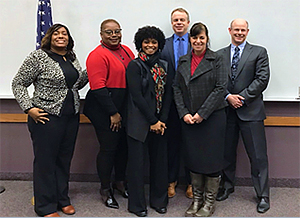 On January 29, 2020, representatives from the Office of Justice Programs (OJP) and other Department of Justice bureaus offered presentations in Pierre, SD, to help rural and tribal organizations and agencies apply for OJP funding. Shown (from l. to r.) are Kathy Mitchell, Program Manager, OJJDP; Geislia Barnes, State Policy Advisor, Bureau of Justice Assistance (BJA); Chyrl Jones, Deputy Administrator, OJJDP; Joel Hall, Victim Justice Program Specialist, Office for Victims of Crime; Maria Fryer, Senior Policy Advisor, BJA; and Andy Dorr, Assistant Director for Grants Administration, Office of Community Oriented Policing Services.
On January 29, 2020, representatives from the Office of Justice Programs (OJP) and other Department of Justice bureaus offered presentations in Pierre, SD, to help rural and tribal organizations and agencies apply for OJP funding. Shown (from l. to r.) are Kathy Mitchell, Program Manager, OJJDP; Geislia Barnes, State Policy Advisor, Bureau of Justice Assistance (BJA); Chyrl Jones, Deputy Administrator, OJJDP; Joel Hall, Victim Justice Program Specialist, Office for Victims of Crime; Maria Fryer, Senior Policy Advisor, BJA; and Andy Dorr, Assistant Director for Grants Administration, Office of Community Oriented Policing Services.“The presentations discussed funding opportunities out of the various OJP bureaus,” said OJJDP Program Manager Kerri Strug, who led a training on OJJDP funding opportunities and grant requirements in Rio Rancho, NM. “It provided those in the room an opportunity to see that there are a lot of different options available to them, and they can apply and tailor their program needs to the many different solicitations offered by OJP.”
OJP, which comprises six offices (including OJJDP), provides grants, training, research, and statistics to the criminal justice community. It is one of three grantmaking components of the Department of Justice. The other two grantmaking components are the Office on Violence Against Women and the Office of Community Oriented Policing Services.
Resources:
OJJDP Funding: This section of the OJJDP website offers an overview of the OJJDP grant and funding process, current funding opportunities, past funding, OJJDP’s performance measurement system, and other resources to assist applicants.
OJP Grant Application Resource Guide: Revised for fiscal year 2020, this guide contains information and assistance to help applicants prepare and submit applications for OJP funding.
OJP Funding Resource Center: Find current opportunities, solicitation requirements, forms and worksheets, and post-award instructions to help applicants apply for and manage OJP awards.
DOJ Grants Financial Guide: Learn about the laws, rules, and regulations that affect the financial and administrative management of an OJP award.
 According to Child Maltreatment 2018, a report issued by the Department of Health and Human Services, American Indian and Alaska Native children have the highest rate of victimization of any race or ethnicity. In Alaska Native villages and other remote tribal communities throughout the United States, accessing medical and legal services to help children who have been physically or sexually abused is a serious challenge. Services are often many miles away and scattered in disparate locations.
According to Child Maltreatment 2018, a report issued by the Department of Health and Human Services, American Indian and Alaska Native children have the highest rate of victimization of any race or ethnicity. In Alaska Native villages and other remote tribal communities throughout the United States, accessing medical and legal services to help children who have been physically or sexually abused is a serious challenge. Services are often many miles away and scattered in disparate locations.
To address this urgent need for centralized and accessible services, OJJDP will be making grant awards in fiscal year (FY) 2020 totaling $14 million to develop, expand, and build the capacity of children’s advocacy centers (CACs) in Alaska and tribal communities in the lower 48 states. The funding was made available to OJJDP by the Office of Justice Programs’ Office for Victims of Crime.
Using a multidisciplinary team approach, CACs coordinate the investigation and prosecution of child abuse cases and the treatment of victims. These child-focused centers bring together professionals in medicine, law enforcement, child protective services, prosecution, victim advocacy, and mental health to offer services in one location. Working together, these professionals conduct interviews and make team decisions about the investigation, treatment, management, and prosecution of child abuse cases.
CACs exist in strategic locations throughout Alaska; however, there is a need for additional resources to meet the needs of children in other remote areas of the state. Through its FY 2020 Alaska Children's Advocacy Center Expansion Initiative for Child Abuse Victims, OJJDP will fund the development of new satellite CACs, supervised by a National Children’s Alliance-accredited CAC. In addition, OJJDP will expand the capacity of existing Alaska CACs by increasing the number of mental health, forensic, and advocacy services professionals and providing specialized equipment and transportation services.
OJJDP’s Tribal Children’s Advocacy Center Expansion Initiative for Child Abuse Victims will fund the development of new satellite CACs for federally recognized tribes in the lower 48 states.
A third FY 2020 OJJDP grant will fund a training and technical assistance provider to guide and support these projects.
Through Victims of Child Abuse Act programs, OJJDP supports the development and expansion of CACs in communities throughout the country. Last year, more than 880 CACs served 367,797 children nationwide.
April Is Child Abuse Prevention Month
On March 31, 2020, President Donald J. Trump proclaimed April as National Child Abuse Prevention Month to encourage action to improve the safety and well-being of children. Following are helpful resources for professionals and others committed to preventing and mitigating the effects of child abuse:
- The Department of Health and Human Services’ National Child Abuse Prevention Month website provides the latest resources and outreach materials on engaging communities in the prevention of child abuse.
- The National Children’s Advocacy Center (NCAC), which developed the CAC model, provides in-person and online trainings on how to recognize and support maltreated children. NCAC’s annual International Symposium on Child Abuse addresses all aspects of child maltreatment, including physical abuse, sexual abuse, neglect, trafficking, prevention, and intervention.
- NCAC’s Child Abuse Library Online (CALiO) contains thousands of publications, videos, audio files, articles, and reports that promote evidence-based practices to prevent and address child maltreatment.
- To learn more about how OJJDP is working to address child abuse through partnerships, programs, and training and technical assistance, visit the Office’s Child Abuse Prevention webpage.

 Janet Chiancone, OJJDP Associate Administrator
Janet Chiancone, OJJDP Associate AdministratorAssociate Administrator Janet Chiancone oversees OJJDP’s Budget and Administration Division, which handles all agency budget and administrative matters, including human resources, the OJJDP budget, and grantee performance measures.
Ms. Chiancone’s division is responsible for budget development and execution for OJJDP grants and interagency agreements. In fiscal year 2019, OJJDP made approximately 323 awards totaling more than $323 million to protect public safety, ensure offenders are held accountable, and empower youth to live productive and law-abiding lives.
The division also oversees the Office’s operations budget—which supports staff travel, training, and OJJDP contracts—as well as day-to-day operations, including time and attendance, space assignment, work order submissions, and workforce management. In addition, division staff serve as liaisons to other Office of Justice Programs support offices, such as the Office of Administration, Office of the Chief Financial Officer, and Office of the Chief Information Officer.
During her 22-year tenure at OJJDP, Ms. Chiancone has served in a variety of roles, including acting deputy administrator for programs, associate administrator for budget and planning, research coordinator, and social science program specialist. She is the author or coauthor of more than a dozen publications, including OJJDP Research 2000 and OJJDP Research: Making a Difference for Juveniles. Ms. Chiancone is a recipient of the Assistant Attorney General’s Award.
Before joining OJJDP, Ms. Chiancone worked as a research associate at the American Bar Association Center on Children and the Law, where she conducted research on parental kidnapping and child dependency court improvement. Her prior experience includes coordinating a local Court Appointed Special Advocates program and managing a Department of Education-funded research project that examined the impact of Head Start programs on homeless children and their families. She began her career working on community development, housing, and homelessness issues as a program developer. She earned a master’s degree in family and community development from the University of Maryland. Her master’s thesis examined the circumstances of homeless women who are separated from their children.
Between 1997 and 2017, the number of youth held in juvenile residential facilities nationwide decreased 59 percent. Despite this progress, challenges remain. Violations of the requirements of court-ordered community supervision—such as skipping school and missing appointments with a probation officer—are a major contributing factor to the placement of young people, particularly youth of color.
Graduated response approaches, which use a range of sanctions for violations and incentives for continued progress, offer a promising avenue for holding youth accountable and promoting prosocial behavior without relying on detention and incarceration. These approaches have been found to improve outcomes for adult and juvenile drug offenders. However, very little research has established the effectiveness of these approaches with juvenile offenders more generally.
To address this information gap, OJJDP in fiscal year 2016 funded a research study that examined the Accountability and Incentives Management system (AIM), launched by the Maryland Department of Juvenile Services in 2015. AIM provides structured guidance tools to case managers in responding to youth behavior. The tools offer a range of options to tailor sanctions and incentives to individual youth. AIM training generally has focused on the need for responses to be certain, swift, and proportionate to the behavior to achieve positive results.
The study sample included 1,983 youth who started and ended community supervision between Nov. 1, 2015, and Oct. 31, 2017. Of those youth, 80.7 percent were male, 68.9 percent were black, and 24.7 percent were white. The average age at the start of supervision was 16. Most youth (90.8 percent) were under probation supervision, and 9.2 percent were under aftercare supervision.
Researchers compared this group with a group of youth supervised before AIM was implemented. They used a technique known as propensity score matching to ensure the two groups were statistically equivalent on a variety of demographic and other variables, such as offense, risk level, and treatment needs. The study capitalized on the comprehensive data collected in the Department of Juvenile Services’ information systems, including data related to AIM implementation.
The research study included the following questions:
- To what extent did case managers implement AIM as intended?
- Did the implementation of AIM improve outcomes for youth under community supervision?
The study found that just over half of youth supervised with AIM in place received at least one sanction or incentive during their supervision. Responses to positive and negative behaviors were applied relatively swiftly—within 3 days on average—and staff followed the structured guidance for sanctions in almost all of their decisions.
Sanctions were more commonly applied than incentives, countering the generally recommended practice of a 4:1 ratio between incentives and sanctions. The most common incentive was verbal praise. These findings suggest that staff would benefit from additional training and coaching to reinforce the use of incentives, including those that increase privileges or decrease restrictions and supervision levels.
Among the most promising findings were those related to youth outcomes. Youth supervised following AIM implementation were significantly less likely to have a violation of probation filed with the court, be placed in a committed residential placement, or commit an offense resulting in adjudication during supervision, relative to the comparison group.
One goal of AIM was to reduce racial and ethnic disparities in the Department of Juvenile Services’ detention and committed population. Study findings showed that, among youth who received a graduated response, black youth were more likely than white youth to receive sanctions over incentives. However, the outcomes of AIM did not vary by race; both groups were less likely to have a violation of probation filed with AIM in place.
Resource:
The report Assessing the Impact of a Graduated Response Approach for Youth in the Maryland Juvenile Justice System is available online.
Please be advised that many agencies and organizations are in the process of rescheduling in-person training and technical assistance events in response to the COVID-19 pandemic. Check their websites for updated information.
 Sexual Offenses: Mind and Motivation: May 4–5, 2020
Sexual Offenses: Mind and Motivation: May 4–5, 2020
This training, to be held in Chandler, AZ, will offer an introduction into the mindset of those who commit sexually motivated crimes. Attendees will learn about sex offender typologies and patterns of behavior. The training will explore the relationship between paraphilia (e.g., exhibitionism, voyeurism, and fetishism) and criminal acts. Participants will discuss actual case examples to gain insight into offenders’ methods. The training is offered by the OJJDP-sponsored National Criminal Justice Training Center. Registration information is available online.
The training will also be held August 3–4 in Appleton, WI, and September 16–17 in Mansfield, MA.
Multidisciplinary Team Response to Child Sex Trafficking: May 4–7, 2020
This no-cost training, offered by the National Criminal Justice Training Center, will improve multidisciplinary team (MDT) responses to child sex trafficking cases and help those who want to establish a formal MDT in their community to effectively respond to child sex trafficking. Subject matter experts will work with teams to identify gaps and develop short- and long-term response plans. The training will be held in Columbus, OH. Registration information is available online.
This training will also take place August 31–September 3 in Memphis, TN, and November 16–19 in Denver, CO.
Conducting Unexplained Child Death Investigations: May 11–14, 2020
To be held in Birmingham, AL, this no-cost training will discuss statistics, causes, and risk factors in cases involving child deaths. The training, presented by the National Criminal Justice Training Center, will also focus on legal issues and considerations, child development, the medical response to pediatric emergencies, investigator roles and responsibilities in cooperation with the medical examiner, the initial response to a child death and protection of the death scene to avoid contamination of evidence, and digital evidence. Registration information is available online.
The training will also be held August 24–27 in Phoenix, AZ.

Webinar: AMBER Alert Best Practices—Law Enforcement Field Guide: May 14, 2020, 2–3:15 p.m. (ET)
The AMBER Alert Best Practices -- Law Enforcement Field Guide is a companion to the AMBER Alert Best Practices Guide and is aimed at law enforcement agencies and first responders. It is designed to provide administrators with a document on what to expect in the event of an endangered missing or abducted child investigation, as well as provide their personnel with a reference manual to help jump start an effective response and investigation. The webinar will focus on raising awareness of areas that are consistently shown to be relevant and have an operational impact in these types of cases as well as how the guide can assist. Registration information is available online.
Child Homicide Investigations: May 18–19, 2020
The National Criminal Justice Training Center will hold this training in Aurora, CO. It will focus on understanding and building relationships between forensic pathologists, homicide investigators, and prosecutors to successfully investigate and prosecute child homicide cases. The training is designed for prosecutors as well as court system, law enforcement, social work, and victim service professionals. Registration information is available online.
The training will also be held June 1–2 in Ponderay, ID.All Rise 20 Conference: May 27–30, 2020

The National Association of Drug Court Professionals hosts an annual conference on addiction, mental health, and justice reform. The conference brings together leaders from all models of treatment courts, the recovery community, law enforcement, veteran service organizations, legislators, and other key stakeholders to learn the latest evidence-based practices for serving individuals with substance use and mental health disorders. The conference offers continuing legal education, continuing judicial education, and continuing education units for most states. Registration information is available online.
Psychology of School Threat Assessments: June 10–11, 2020
Presented by the National Criminal Justice Training Center, this training examines the psychological and behavioral aspects of threat assessment and management. The training, to be held in Miami, FL, will explore normal versus abnormal child and adolescent behaviors, strategies for identifying red flags, and how threats can be managed along a pathway toward violence (both short and long term) to ensure safety. Attendees will learn multidisciplinary threat assessment and management strategies and explore risk and protective factors for youth violence. Registration information is available online.
The training will also be offered September 21–22 in Franklin, TN, and October 5–6 in Chandler, AZ.
School Resource Officer Training Conference: June 16–18, 2020
This conference for law enforcement and school personnel will address school violence and youth victimization concerns using crime prevention and response strategies. The conference, hosted by the National Criminal Justice Training Center, will review lessons learned from relevant case studies, examine the impacts of trauma on youth, explore trends related to social media use by young people, and discuss successful prevention and intervention program models. The event will take place in Appleton, WI. Registration information is available online.
Improving Youth Interactions Through Fair and Impartial Justice: June 17–18, 2020
This training, offered by the National Criminal Justice Training Center, is designed to support law enforcement in fostering strong community relationships, enhancing interactions with youth, and creating effective interventions to divert at-risk and minority youth from the justice system. The training will be held in the San Francisco area. Registration information is available online.
Forensic Interviewing of Children: June 22–26, 2020
Presented by the National Children’s Advocacy Center (NCAC), this training is intended for professionals with less than 2 years of experience conducting forensic interviews of children, experienced child abuse professionals seeking to sharpen existing skills, and professionals who want to learn about the current NCAC Child Forensic Interview Structure. The course will be held in Huntsville, AL. Registration information is available online.
 National Council of Juvenile and Family Court Judges 83rd Annual Conference: July 19–22, 2020
National Council of Juvenile and Family Court Judges 83rd Annual Conference: July 19–22, 2020
The 83rd annual conference will feature presentations on issues facing the juvenile and family court systems. It will include training tracks on family law, juvenile justice, child welfare, and family violence. There will also be tracks featuring practical and innovative solutions. The event will be held in Reno, NV. Registration information is available online.
Conducting Child Abuse Investigations: July 27–31, 2020
To be held in St. Louis, MO, this no-cost training will offer the latest information on the investigation and prosecution of child abuse cases using a multidisciplinary team approach. Attendees will learn about medical evidence, techniques for interviewing child victims/witnesses as well as adult suspects/witnesses, and legal issues and considerations in child physical and sexual abuse cases. The training is offered by the National Criminal Justice Training Center. Registration information is available online.
Deputy Administrator Discusses 2020 Programs at National Association of Counties Legislative Conference
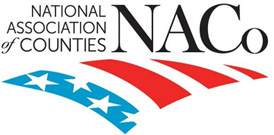 On February 29–March 4, 2020, the National Association of Counties (NACo) held its Legislative Conference in Washington, DC. On the conference’s opening day, Deputy Administrator Chyrl Jones joined representatives of other Department of Justice grantmaking agencies in a panel discussion on federal priorities, policy changes, and programs to deter crime and protect public safety. Other participants in the panel discussion, “Federal Policy and Programs Outlook,” included Tracey Trautman, then-Acting Director of the Bureau of Justice Assistance, and Cory Randolph, Deputy Director for Grants at the Office of Community Oriented Policing Services.
On February 29–March 4, 2020, the National Association of Counties (NACo) held its Legislative Conference in Washington, DC. On the conference’s opening day, Deputy Administrator Chyrl Jones joined representatives of other Department of Justice grantmaking agencies in a panel discussion on federal priorities, policy changes, and programs to deter crime and protect public safety. Other participants in the panel discussion, “Federal Policy and Programs Outlook,” included Tracey Trautman, then-Acting Director of the Bureau of Justice Assistance, and Cory Randolph, Deputy Director for Grants at the Office of Community Oriented Policing Services.
Deputy Administrator Jones provided an overview of OJJDP’s fiscal year 2020 funding programs. She highlighted OJJDP’s support of mentoring—including mentoring for youth in the juvenile justice system and youth impacted by the opioid crisis—and programs to support successful reentry for youth offenders, services for child victims of sex trafficking, juvenile drug treatment courts, and family drug courts. In addition, Ms. Jones encouraged county agencies to use OJJDP’s training and technical assistance resources, Statistical Briefing Book, and Model Programs Guide.
Established in 1935, NACo advocates for county priorities in federal policymaking and enhances public understanding of county government. The association serves nearly 40,000 county elected officials and 3.6 million county employees.
OJJDP’s State Relations and Assistance Division Holds Audit Training
On February 10–13, 2020, the State Relations and Assistance Division (SRAD), in collaboration with the Government Audit Training Institute, provided an audit training for division staff. SRAD offers guidance and specialized assistance to ensure that states comply with the core requirements of the Juvenile Justice and Delinquency Prevention Act. The division also conducts audits to assess the effectiveness of states’ compliance monitoring systems.
Focusing on performance and compliance auditing, the training provided information about the phases of auditing—planning, fieldwork, and reporting—as well as techniques for conducting each phase. In addition, participants learned about methods for collecting, documenting, and ensuring the reliability of different types of evidence that support findings and recommendations resulting from audits. The training also included an overview of the Generally Accepted Government Auditing Standards (GAGAS). The standards include independence, transparency, accountability, and quality.
“The training was a critical step toward ensuring that SRAD staff are trained to conduct monitoring and compliance field audits with fidelity and consistency using GAGAS,” said Dr. TeNeane Bradford, who heads the division. “Moving forward, staff will continue to receive quality training that will yield impactful results. These results will capture an accurate picture of state monitoring systems and inform OJJDP about their funding and training and technical assistance needs.”
Notice About Missing Children’s Day and COVID-19
The U.S. Department of Justice is closely monitoring the situation surrounding the Coronavirus Disease of 2019 (COVID-19). We remain committed to observing National Missing Children's Day on Wednesday, May 20. However, we will not hold an in-person ceremony this year. As soon as a final decision is reached on the format used for this recognition, we will be sure to communicate that information to you. Thank you and stay safe.
Additional Video Recordings From OJJDP Training Conference Available Online
At OJJDP’s National Training Conference in September 2019, approximately 200 participants engaged in interactive discussions, panels, and workshops to enhance implementation of OJJDP’s Title II Formula Grants program and support compliance with the core requirements of the Juvenile Justice and Delinquency Prevention Act. The conference was organized by the Office’s State Relations and Assistance Division.
OJJDP has made available video recordings of conference sessions and interviews with participants on the Office’s State Relations and Assistance Division National Training Conference webpage. The following recordings were recently added to the webpage:
- A discussion with youth members of state advisory groups about the importance of youth engagement in juvenile justice.
- A question-and-answer session with members of the Federal Advisory Committee on Juvenile Justice.
- An interview with FACJJ subcommittee members, in which they discuss their work and priorities. The FACJJ subcommittees are Educating the Field, Facilitating Compliance With the Juvenile Justice Reform Act, and Special Topics.
- An update of the Government Accountability Office’s audits of OJJDP and its grantees, as mandated by the Juvenile Justice Reform Act.
National Law Enforcement Training on Child Exploitation Planned for June
 Since its inception in 1998, OJJDP’s Internet Crimes Against Children (ICAC) Task Force program has helped state and local agencies to develop effective, sustainable responses to online child victimization, including responses to the online sharing of child sexual abuse images. The program has increased the capacity of thousands of communities across the country to combat Internet crimes against children.
Since its inception in 1998, OJJDP’s Internet Crimes Against Children (ICAC) Task Force program has helped state and local agencies to develop effective, sustainable responses to online child victimization, including responses to the online sharing of child sexual abuse images. The program has increased the capacity of thousands of communities across the country to combat Internet crimes against children.
The ICAC Training and Technical Assistance program was established to provide ICAC task forces and their affiliates with the training and technical assistance they need to conduct effective investigations and prosecutions. As part of this commitment, OJJDP and its Department of Justice partners host an annual National Law Enforcement Training on Child Exploitation. The training shares the latest techniques on how to combat child exploitation in the ever-changing Internet environment. The training also offers an opportunity for ICAC task forces and their affiliates to share information and improve collaboration to stop technology-facilitated crimes against children.
The 2020 training, still in the planning stages, is scheduled for June in Atlanta, GA. Additional information will be made available in the near future. More than 1,600 attendees from 495 agencies and 61 ICAC task forces participated in last year’s training.
SchoolSafety.gov Launched To Help Educators Prepare for Threats
 The Trump Administration recently launched the federal school safety clearinghouse website SchoolSafety.gov. The site is a resource for the American public, primarily K–12 school administrators, to access free information, guidance, best practices, and tools to promote school safety. The site includes:
The Trump Administration recently launched the federal school safety clearinghouse website SchoolSafety.gov. The site is a resource for the American public, primarily K–12 school administrators, to access free information, guidance, best practices, and tools to promote school safety. The site includes:
- A school safety readiness tool, an assessment that assists users in evaluating their school’s efforts across 10 foundational elements of school safety. After completing the assessment, users are provided an action plan with task prioritization, options for consideration, aligned resources, and grant opportunities specific to individual needs.
- A secure information-sharing platform for designated school personnel to share school safety ideas, practices, plans, and tactics in a protected environment.
- Resources to help schools create and maintain a safe learning environment.
Three Practices Rated “Effective” by CrimeSolutions.gov
 CrimeSolutions.gov—a National Institute of Justice resource that informs practitioners and policymakers about what works, what doesn't, and what's promising—has rated family-based treatment “effective” in decreasing the rate of rearrest in adolescents. Family-based interventions are designed to decrease adolescent antisocial behaviors by making positive changes in their familial and social environments. Family-based treatment was rated “promising” for improving mental health and behavioral health, decreasing substance use and abuse, and improving school performance.
CrimeSolutions.gov—a National Institute of Justice resource that informs practitioners and policymakers about what works, what doesn't, and what's promising—has rated family-based treatment “effective” in decreasing the rate of rearrest in adolescents. Family-based interventions are designed to decrease adolescent antisocial behaviors by making positive changes in their familial and social environments. Family-based treatment was rated “promising” for improving mental health and behavioral health, decreasing substance use and abuse, and improving school performance.
CrimeSolutions.gov also rated school-based interventions to reduce exclusion as “effective.” School exclusion (more commonly known as suspension and expulsion) is broadly defined as a disciplinary measure imposed in reaction to students’ misbehavior. This practice comprises school-based programs that seek to decrease the prevalence of exclusion and thereby reduce the detrimental effects that suspension or expulsion from school may have on students’ learning outcomes and future training or employment opportunities.
Finally, cyberbullying prevention and intervention programs have been rated “effective” for reducing cyberbullying perpetration and victimization. This practice encompasses intervention and prevention programs that are designed to reduce or prevent negative online behaviors among children ages 9 to 19. Programs include individual-level, multilevel systemic, and universal or whole-school approaches.
All OJJDP publications may be viewed and downloaded on the publications section of the OJJDP website. Print publications may be ordered online at the National Criminal Justice Reference Service website.

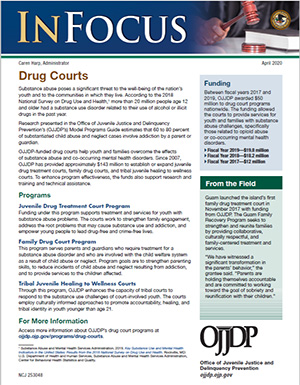 Drug Courts (In Focus Fact Sheet)
Drug Courts (In Focus Fact Sheet)
NCJ 253048
OJJDP-funded drug courts help youth and families overcome the effects of substance abuse and co-occurring mental health disorders. This fact sheet describes OJJDP’s Juvenile Drug Treatment Court program, Family Drug Court program, and Tribal Juvenile Healing to Wellness Courts program. In addition, the fact sheet provides a summary of OJJDP funding to support drug courts for fiscal years 2017 through 2019.
View and download this publication.

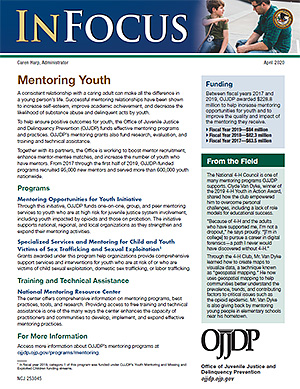 Mentoring Youth (In Focus Fact Sheet)
Mentoring Youth (In Focus Fact Sheet)
NCJ 253045
From 2017 to through the first half of 2019, OJJDP-funded programs recruited 95,000 new mentors and served more than 600,000 youth nationwide. This fact sheet offers an overview of OJJDP’s Mentoring Opportunities for Youth initiative and National Mentoring Resource Center. It also provides a summary of OJJDP funding to support youth mentoring for fiscal years 2017 through 2019.
View and download this publication.
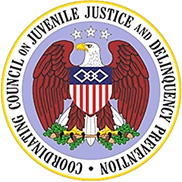
On any given day, there are more than 43,000 juvenile offenders in residential placement nationwide. Although the rate of youth incarceration has continued to decline over the past 10 years, the development of comprehensive and effective approaches for reducing recidivism remains a challenge for most state and local agencies. Youth returning to their communities after placement often require community-based services and supports in education, housing, employment, medical care, and mental health.
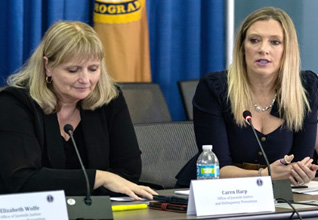 Principal Deputy Assistant Attorney General Katharine T. Sullivan (right) and OJJDP Administrator Caren Harp offered remarks at the Council meeting. Ms. Sullivan is Vice Chair of President Trump’s Commission on Law Enforcement and the Administration of Justice. Quoting the President, she said, “We’re all better off when former inmates can reenter society as law-abiding, productive citizens.”
Principal Deputy Assistant Attorney General Katharine T. Sullivan (right) and OJJDP Administrator Caren Harp offered remarks at the Council meeting. Ms. Sullivan is Vice Chair of President Trump’s Commission on Law Enforcement and the Administration of Justice. Quoting the President, she said, “We’re all better off when former inmates can reenter society as law-abiding, productive citizens.”OJJDP Deputy Associate Administrator Sanzanna Dean opened the discussion of federal reentry initiatives with an overview of the Office’s Second Chance Act programs, which encourage collaboration between state agencies, local government, and community-based organizations to address the challenges that reentry poses for juvenile offenders and their families. She highlighted OJJDP’s Reentry Starts Here: A Guide for Youth in Long-Term Juvenile Corrections and Treatment Programs. The guide provides youth, family, and reentry staff with key information on how to support youth as they prepare to return to their communities upon release.
Jennifer Kemp, Director of Youth Services in the Department of Labor’s (DOL’s) Office of Workforce Investment, presented on DOL’s Reentry Employment Opportunities program, which serves youth and young adults who are currently or were previously involved in the juvenile or adult justice systems. The program offers a range of services, including tutoring, high school equivalency preparation, mentoring, occupational skills training, career counseling, job placement, and referral to other resources. Those resources include the DOL-supported American Job Center Network’s CareerOneStop, which offers information about job openings and training opportunities throughout the country. Ms. Kemp added that employers are often uncomfortable hiring people who have a criminal record. DOL’s Federal Bonding Program funds liability insurance to cover the first 6 months of employment, at no cost to the employer or job applicant. “Some people have misconceptions about people who have been involved in the justice system, that they might have liabilities,” she said. “But in the 50 years we’ve had this program, we’ve paid out less than 1 percent.”
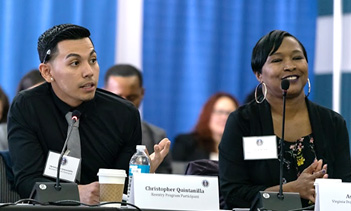 Christopher Quintanilla was recently released from Virginia’s Bon Air Juvenile Correctional Center. He now works as a barber and attends Northern Virginia Community College part time, majoring in organizational psychology. “I’m an aspiring psychologist and youth advocate,” he said. “When you’re transitioning [back to your community], it takes hard work and effort. . . . I like how [things] are moving forward, not getting worse.”
Christopher Quintanilla was recently released from Virginia’s Bon Air Juvenile Correctional Center. He now works as a barber and attends Northern Virginia Community College part time, majoring in organizational psychology. “I’m an aspiring psychologist and youth advocate,” he said. “When you’re transitioning [back to your community], it takes hard work and effort. . . . I like how [things] are moving forward, not getting worse.”Ashaki McNeil, Director of the Virginia Department of Juvenile Justice’s Reentry Unit, described how OJJDP’s Second Chance Act funding has helped the department build stakeholder partnerships, develop a full continuum of evidence-based services across residential and community programs, and increase family involvement in the reentry process.
Virginia’s Reentry Task Force, which meets monthly, has created memorandums of understanding that have strengthened partnerships between youth-serving agencies that provide social, behavioral health, medical, juvenile justice, and workforce development services. Community colleges are partnering with the task force to assist youth in pursuing higher education. In addition, Virginia’s Department of Juvenile Justice has increased supports and training for its staff. “It’s important to change the culture,” Ms. McNeil said. “If you treat the staff right, they treat the kids right.” The department has also added staff to coordinate family engagement activities and arranged for no-cost transportation for families to visit youth. After release, transitional housing is provided for youth who need it.
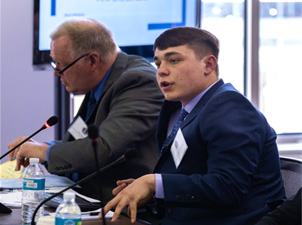 Levi Kranz, a high school junior from Iowa, described the mentoring, life skills, psychological, and workforce development services that helped him transition back into his community. On the left is Dave Kuker, Executive Officer at the Iowa Department of Human Rights’ Division of Criminal and Juvenile Justice Planning.
Levi Kranz, a high school junior from Iowa, described the mentoring, life skills, psychological, and workforce development services that helped him transition back into his community. On the left is Dave Kuker, Executive Officer at the Iowa Department of Human Rights’ Division of Criminal and Juvenile Justice Planning.The meeting concluded with a personal testimony and recommendations from Levi Kranz, a high school junior from Sioux City with experience in an Iowa drug treatment program and two of the state’s juvenile justice residential facilities.
Levi’s life was changed by his experiences at the State Training School (STS) in Eldora, IA. There, Levi encountered mentors previously involved in the justice system who had turned their lives around. “They helped because they were really understanding,” Levi said. “I realized that I wanted to change.” STS offered vocational and recreational programming, and Levi now plans to become an apprentice in carpentry after completing high school and wants to build his own home one day. He and his mother participated in Functional Family Therapy sessions. He said that these sessions “helped me and my mom get back on the same page and communicate better.” Finally, while at STS, Levi participated in YTDM sessions. “We made all these goals, and I [saw that I] could actually do something better when I got out,” he said.
The Juvenile Justice and Delinquency Prevention Act of 1974, as amended, established the Council as an independent body to coordinate federal programs related to delinquency prevention and missing and exploited children. The Council comprises 9 ex officio members, 4 affiliate members, and 10 nonfederal practitioner members named by the President and Congress. The Attorney General is the ex officio Chair of the Council and the Administrator of OJJDP is the ex officio Vice Chair. Additional ex officio members include the Secretaries of the Departments of Health and Human Services (HHS), Labor, Education, Homeland Security, and Housing and Urban Development; the Director of the Office of National Drug Control Policy; and the Chief Executive Officer of the Corporation for National and Community Service. In addition, four affiliate federal agencies are represented on the Council: the Departments of Agriculture, Defense, and Interior, through their respective Secretaries and designees; and HHS’ Substance Abuse and Mental Health Services Administration, through its Administrator. In accordance with the Federal Advisory Committee Act, the Council holds public meetings up to four times a year in which members discuss activities to facilitate and support cross-agency coordination.
The Federal Advisory Committee on Juvenile Justice (the FACJJ) held an in-person meeting on March 6, 2020, at the Office of Justice Programs in Washington, DC. OJJDP Administrator Caren Harp opened the meeting by introducing and welcoming a new FACJJ member, Russ Riehl. Mr. Riehl is Principal of Simle Middle School in Bismarck, ND, and a member of the North Dakota Governor’s Committee on Juvenile Justice.
Kim Godfrey Lovett, Executive Director of the Performance-based Standards (PbS) Learning Institute, provided an overview of PbS' data-driven approach to improving the operations, programs, and services of juvenile justice facilities and programs. PbS uses a continuous improvement model that allows participants to monitor progress on an ongoing basis. The goal is to ensure a safe and healthy environment and effective services that help young offenders return to the community and lead productive, law-abiding lives.
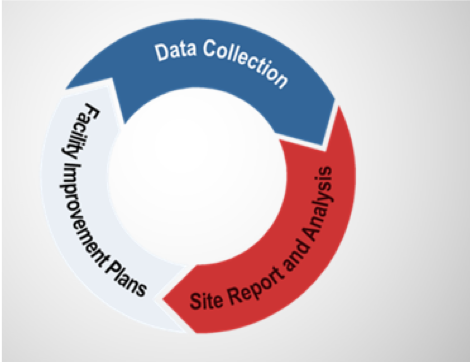 PbS builds performance improvement and accountability into juvenile justice facility operations using a three-part continuous improvement cycle: (1) collecting data, (2) analyzing the performance outcomes and summary data reports, and (3) using the data to create improvement and reforms.
PbS builds performance improvement and accountability into juvenile justice facility operations using a three-part continuous improvement cycle: (1) collecting data, (2) analyzing the performance outcomes and summary data reports, and (3) using the data to create improvement and reforms.Following Ms. Godfrey Lovett's presentation, Administrator Harp and Dr. TeNeane Bradford, head of the Office's State Relations and Assistance Division, provided a brief history of the Juvenile Justice and Delinquency (JJDP) Act and the Title II Formula Grants program. Since 1974, OJJDP has administered the Formula Grants program to support state and local delinquency prevention and intervention efforts and juvenile justice system improvements and to ensure compliance with the JJDP Act's core requirements.
A major focus of discussion was the “85 percent rule,” one of the criteria by which states are deemed eligible to participate in the Formula Grants program. The rule stipulates that states must submit 12 months of compliance data for 85 percent of their facilities to be deemed eligible to participate in the applicable award year. “Recently, there have been more states deemed ineligible than in the past,” Administrator Harp said. “This has been an unintended consequence of our seriousness about implementing the Act.”
If a participating State, despite its good faith efforts, fails to demonstrate compliance with the JJDP Act's core requirements in any year, OJJDP will reduce its formula grant for the subsequent fiscal year by 20 percent for each requirement for which the State is noncompliant. States must use 50 percent of their allocations for that award period to achieve compliance.
 The FACJJ meeting's afternoon session opened with a walk-through of OJJDP's redesigned website by Web Content Manager Jill Molter. The site offers state-of-the-art global search capabilities. Visitors can search by keyword and narrow search results by type of information, such as funding, programs, events, publications, and multimedia. Many webpages allow visitors to search within the page content or use filters to find what they need. The site now ensures a successful web experience, whether visitors are accessing the site on a desktop, tablet, or mobile device.
The FACJJ meeting's afternoon session opened with a walk-through of OJJDP's redesigned website by Web Content Manager Jill Molter. The site offers state-of-the-art global search capabilities. Visitors can search by keyword and narrow search results by type of information, such as funding, programs, events, publications, and multimedia. Many webpages allow visitors to search within the page content or use filters to find what they need. The site now ensures a successful web experience, whether visitors are accessing the site on a desktop, tablet, or mobile device.
In addition, the website now features detailed information about OJJDP's work with the states and territories. The state pages focus on Title II Formula Grants funding determinations and reporting in a range of areas, including state 3-year plans, compliance information, and disproportionate minority contact. The pages also provide a listing of all active OJJDP awards for individual states and territories.
Later in the afternoon, FACJJ members identified areas of focus for the coming year. The Subcommittee on Facilitating Compliance With the Juvenile Justice Reform Act will continue to assist OJJDP with clarifying terminology and implementing the Juvenile Justice Reform Act of 2018. The Subcommittee on Educating the Field has completed its work, and a new Subcommittee on Engaging Territories and Nonparticipating States was formed. This subcommittee will focus on addressing the challenges faced by U.S. territories in carrying out the Formula Grants program. The subcommittee will also assist OJJDP in its outreach to states that are not currently participating in the Title II Formula Grants program. The Subcommittee on Special Topics is considering a number of possible focus areas, including truancy reduction efforts.
OJJDP Program Manager Keisha Kersey closed the meeting with a report on preparations for the State Relations and Assistance Division’s next National Training Conference. The conference will be held October 6–8, 2020.
The Federal Advisory Committee on Juvenile Justice is a consultative body established by the Juvenile Justice and Delinquency Prevention Act of 1974, as amended (Section 223), and is supported by OJJDP. Composed of members of state advisory groups on juvenile justice, the committee advises the President and Congress on matters related to juvenile justice, evaluates the progress and accomplishments of juvenile justice activities and projects, and advises the OJJDP Administrator on the work of OJJDP.